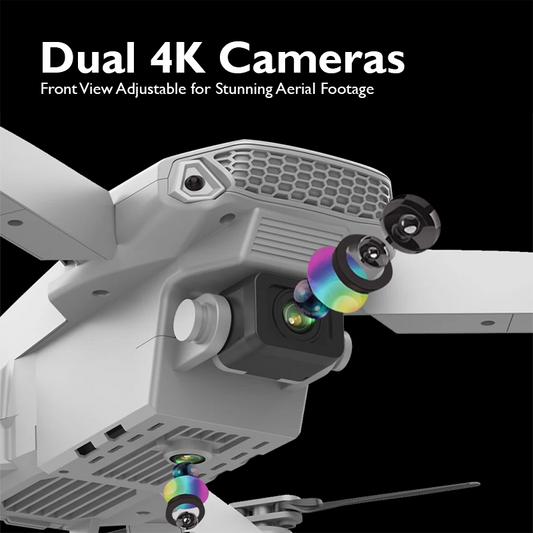Drones in Education: Innovative Learning Tools

In recent years, the integration of technology in education has witnessed a paradigm shift, with drones emerging as one of the most innovative tools. Drones, once primarily associated with aerial photography and recreational activities, are now making their mark in the educational landscape. This article delves into the exciting realm of "Drones in Education," exploring how these unmanned aerial vehicles are revolutionising traditional teaching methods and providing students with unique learning experiences.
The Rise of Drones in Education:

Drones, also known as Unmanned Aerial Vehicles (UAVs), have become more than just a high-tech gadget. Educational institutions worldwide are increasingly recognizing the potential of drones to enhance the learning process. From elementary schools to universities, educators are leveraging drones to engage students in ways that were once unimaginable.
Hands-On Learning Opportunities:

Drones offer a hands-on learning experience that goes beyond textbooks and traditional classroom settings. By incorporating drones into the curriculum, educators can introduce students to real-world applications of science, technology, engineering, and mathematics (STEM) concepts. For example, students can learn about aerodynamics, physics, and geography by piloting drones and understanding their functionalities.
STEM Education Reinvented:

With a growing emphasis on STEM education, drones serve as an ideal tool to spark interest in these subjects. Students not only learn the theoretical aspects but also get to apply their knowledge in a practical setting. Programming drones, understanding flight dynamics, and solving real-world problems through drone technology can instil a passion for STEM subjects early on, potentially paving the way for future careers in these fields.
Enhanced Creativity and Critical Thinking:

Drones encourage creativity and critical thinking by challenging students to solve problems and think innovatively. Designing and building drones require a combination of technical skills and creative problem-solving, fostering a holistic approach to learning. As students navigate the challenges of drone technology, they develop essential skills such as teamwork, communication, and adaptability.
Real-World Applications:
Drones bring real-world applications into the educational sphere. For instance, in geography classes, students can use drones to explore geographical features or map landscapes. In agriculture studies, drones can be employed for precision farming, monitoring crops, and assessing soil conditions. The versatility of drones allows educators to tailor their usage to various subjects, making them a valuable asset across disciplines.
The Benefits of Drones in Education:
1.Engagement and Motivation:

Drones capture students' attention and ignite a sense of curiosity, making learning more enjoyable. The excitement of piloting a drone and witnessing its capabilities firsthand motivates students to actively participate in their education. This increased engagement can lead to a more profound understanding of the subject matter and a greater retention of knowledge.
2.Preparation for Future Careers:

As the use of drones continues to expand across industries, exposure to drone technology in the educational setting prepares students for future career opportunities. Whether in the fields of engineering, agriculture, environmental science, or even filmmaking, familiarity with drone applications gives students a competitive edge in a technology-driven job market.
3.Multidisciplinary Learning:

Drones seamlessly integrate into various subjects, promoting multidisciplinary learning. Students not only gain expertise in operating drones but also acquire knowledge in areas such as data analysis, programming, and problem-solving. This holistic approach to education aligns with the evolving demands of the modern workforce.
4.Inclusivity in Education:
Drones provide an inclusive learning environment by catering to diverse learning styles. Visual and kinesthetic learners, in particular, benefit from the interactive nature of drone-based activities. By accommodating different learning preferences, educators can create a more inclusive educational experience for all students.
Implementing Drones in Educational Institutions:

1.Professional Development for Educators:
Integrating drones into the curriculum requires educators to develop the necessary skills and knowledge. Professional development programs can empower teachers to incorporate drone technology effectively. Workshops, online courses, and collaboration with industry experts can enhance educators' understanding of drones and their educational applications.
2.Establishing Safety Protocols:
Safety is paramount when incorporating drones into educational settings. Establishing clear safety protocols and guidelines ensures a secure learning environment. Educators should prioritise safety training for both themselves and students, covering topics such as drone operation, emergency procedures, and compliance with aviation regulations.
3.Access to Drone Technology:
Providing access to drone technology may pose a logistical challenge for some educational institutions. Collaboration with local businesses, community organisations, or seeking grants can help schools acquire the necessary resources. Additionally, partnerships with drone manufacturers or local drone enthusiasts can facilitate access to equipment and expertise.
4.Collaboration with Industry Professionals:

To enrich the learning experience, educational institutions can collaborate with industry professionals working in drone-related fields. Guest lectures, workshops, and mentorship programs can expose students to real-world applications and career pathways in drone technology.
The integration of drones in education marks a transformative shift in the way students learn and engage with academic content. As innovative learning tools, drones not only capture the imagination of students but also prepare them for the challenges of a technology-driven future. By fostering hands-on experiences, promoting STEM education, and encouraging creativity, drones have the potential to revolutionise education and shape the next generation of thinkers, innovators, and problem solvers. As educational institutions continue to embrace this technology, the sky is truly the limit for the impact of drones on the learning landscape.
Explore a variety of drones at our online drone store.
Happy Flying!











